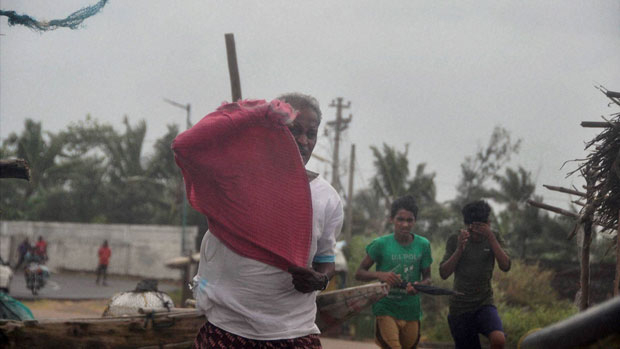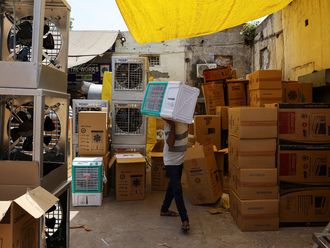
Hyderabad: More than 1,000 rescue workers and soldiers have begun clearing away piles of uprooted trees and electric poles blocking roads after a powerful cyclone slammed into India's eastern seaboard, leaving at least eight dead.
Rescuers were readying dozens of helicopters, aircraft, ships and boats to carry out relief operations once they get a clearer idea of the extent of damage in Andhra Pradesh and Orissa states, said Anil Shekhawat, an Indian official.
Weather forecasters downgraded Cyclone Hudhud to a tropical depression as it moved further inland on a course north-northwest of the city of Visakhapatnam, where it made landfall Sunday.
200kph winds
Cyclone Hudhud, which packed winds of up to 200kph as it slammed into India’s east coast, downed power lines and closed roads and railways.
As it wreaked havoc in north coastal Andhra, it has also damaged Visakhapatnam Airport, snapping the air connectivity with this port city.
The cyclone which hit the coast near the city with strong gales damaged the roof of the airport building, officials said. Flood water also entered the runway, forcing the authorities to suspend all operations.
As a precautionary measure, airport authorities had cancelled all flights to and from the city Sunday but with the cyclone damaging the facility, it may take more time for restoration of services.
Visakhapatnam airport is the biggest domestic and international airport in Andhra Pradesh. The airport in the past used to get frequently inundated due to heavy rains. In 2005, it was shut for more than 10 days due to flooding. However, the authorities have since taken measures to prevent inundation.
Evacuated
But the relatively lower casualty count was down to better disaster preparedness implemented by officials.
Around 400,000 people living along the coast in the worst-hit state of Andhra Pradesh were evacuated before the storm struck around 11.30am (0600 GMT) on Sunday.
More than 100,000 others had been moved from their homes in neighbouring Odisha state by late afternoon as the storm headed for them.
“We have had three deaths since this morning,” said Natrajan Prakasam, a Disaster Management Commission official in Andhra Pradesh in southeast India.
Two people were crushed by falling trees, while the third was killed when a wall collapsed in heavy rain, he told AFP.
The head of the National Disaster Response Force (NDRF) O.P. Singh said the main highway in the port city of Visakhapatnam, which was in the eye of the storm as it hit, was strewn with fallen trees and electricity pylons.
Clearing, evacuation
“The two big challenges facing the NDRF team are clearing roads and evacuation and rescue work,” Singh said.
In Srikakulam, one of the five coastal districts of Andhra Pradesh in the path of the storm, an entire village was cut off in the immediate aftermath of Hudhud’s landfall, he added. However, the exact number of people stranded was still unknown.
India’s east coast and neighbouring Bangladesh are routinely hit by severe storms between April and November that cause deaths and widespread property damage.
The region is populated by fishermen and small-scale farmers, many of whom live in flimsy huts with thatched roofs or shanties.
As the cyclonic winds hurtled north towards Odisha on Sunday afternoon, television footage showed fisherman closely guarding their boats anchored offshore.
More than 8,000 people were killed in Odisha by a cyclone in 1999 and authorities are eager to avoid a repeat of that disaster.
India’s chief federal government officer, Ajit Seth, warned that cyclonic winds were expected until Sunday evening with only a brief lull following the landfall.
“By around 7.00pm the cyclone should lose 50 per cent of its intensity,” he said.
Last year India undertook its biggest-ever evacuation before the arrival of Cyclone Phailin, with about a million people moved from their homes along the east coast.
That cyclone killed at least 18 people and left a trail of destruction, but authorities said the toll could have been much worse without the evacuations.
On Sunday authorities in Odisha said they had evacuated almost 117,000 by late afternoon in anticipation of the cyclone moving towards their state, many of them indigenous people living in mud houses.
P.K. Mohapatra, special relief commissioner of Odisha, told AFP preparations had been made to evacuate another 300,000 “once the cyclone crosses our state and if water levels rise”.
A young man from Odisha said Hudhud seemed less severe than last year’s Phailin.
“Authorities seem more prepared because of past experience,” he told the NDTV television network.
Arvind Kumar, a state government official in Andhra Pradesh, said 300,000 people had been evacuated there and people had been advised to stay indoors.
The meteorological department forecast torrential rain, likely to damage crops, across parts of Central India and its east over the next three days.
Prime Minister Narendra Modi chaired an emergency meeting late Saturday to review preparations for the cyclone.
The navy earlier said it had “assumed a high degree of readiness” and ships equipped with divers, doctors, inflatable rubber boats, helicopters and relief material were on standby.
On Saturday two children and a fisherman died in Odisha during the evacuation operation, a state government official said.
Some of the deadliest storms in history have formed in the Bay of Bengal to India’s east, including one in 1970 that killed hundreds of thousands in modern-day Bangladesh.












